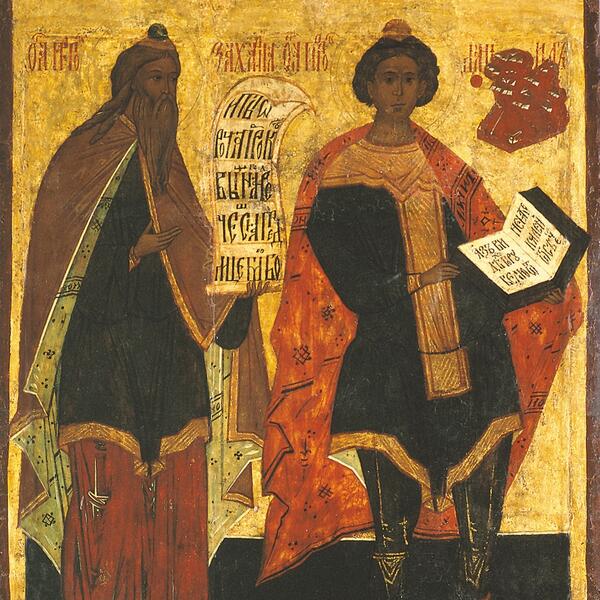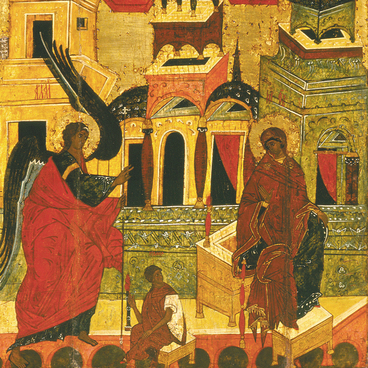The Metropolitan’s Chambers in Yaroslavl house four unique icons which came from the oldest surviving Prophets tier in the city. One of the icons depicts Prophets Zacharias the Righteous and Daniel.
Zacharias the Righteous lived in the 1st century BC. He was the son of Barachias, a descendant of Aaron. Legend has it that Zacharias, as the High Priest of the Temple of Jerusalem, had the honor of presenting the three-year-old Mary in the temple. He and his wife, the righteous Elizabeth, lived a holy life and obeyed God’s law, but for a long time, they remained childless. Once, Zacharias was holding a service on the eighth week and entered the Church for censing. At the altar, Archangel Gabriel appeared to him, announcing the tidings of “joy and gladness”. He said that Zacharias and Elizabeth would have a son, and “many of the children of Israel shall he turn to the Lord their God” (Luke 1:16). For his doubt, Zacharias was struck dumb and was only able to speak again when he named his son John according to the Word of God. His prophecies and words of gratitude spoken at that moment are known in Christian services as the Song of Zacharias.
In the “Icon Painter’s Guide” by the artist and expert of history painting Viktor Fartusov, Prophet Zacharias is described as an old Jewish man, with long gray hair and a thin beard, dressed in a chiton with a belt and a kidar on his head, and holding a scroll in his hands. The scroll usually features words from the Song of Zacharias that is given fully in the Gospel of Luke.
Prophet Daniel from the tribe of Judah lived in the 7th century BC. As a young man, he was taken into captivity in Babylon and spent most of his life at the court of kings Nebuchadnezzar, Darius, and Cyrus. Inspired by Archangel Gabriel, he prophesied about the coming of the Savior and the Kingdom of God. This can be seen in his interpretation of Nebuchadnezzar’s dream about a giant idol smashed by a stone fallen down from the top of the mountain. The stone symbolizes Christ, and the mountain designates the Virgin Mary standing above all the people.
When the Jews were oppressed, Daniel was thrown into a den of lions upon the order of King Darius. However, the animals did not hurt him which led Darius himself to believe in the One God. The time Daniel spent in the den is considered to be the foreshadowing of the Passion of Christ, and his victory over death. Saint Cyril of Alexandria names Prophet Daniel as one of the pre-Christian righteous men who were the first to be led into Paradise by the Savior.
The Book of Daniel with its story about the stone “cut out without hands” is read during the Sunday service. It was also quoted in Old Russian icons of the prophet.
Zacharias the Righteous lived in the 1st century BC. He was the son of Barachias, a descendant of Aaron. Legend has it that Zacharias, as the High Priest of the Temple of Jerusalem, had the honor of presenting the three-year-old Mary in the temple. He and his wife, the righteous Elizabeth, lived a holy life and obeyed God’s law, but for a long time, they remained childless. Once, Zacharias was holding a service on the eighth week and entered the Church for censing. At the altar, Archangel Gabriel appeared to him, announcing the tidings of “joy and gladness”. He said that Zacharias and Elizabeth would have a son, and “many of the children of Israel shall he turn to the Lord their God” (Luke 1:16). For his doubt, Zacharias was struck dumb and was only able to speak again when he named his son John according to the Word of God. His prophecies and words of gratitude spoken at that moment are known in Christian services as the Song of Zacharias.
In the “Icon Painter’s Guide” by the artist and expert of history painting Viktor Fartusov, Prophet Zacharias is described as an old Jewish man, with long gray hair and a thin beard, dressed in a chiton with a belt and a kidar on his head, and holding a scroll in his hands. The scroll usually features words from the Song of Zacharias that is given fully in the Gospel of Luke.
Prophet Daniel from the tribe of Judah lived in the 7th century BC. As a young man, he was taken into captivity in Babylon and spent most of his life at the court of kings Nebuchadnezzar, Darius, and Cyrus. Inspired by Archangel Gabriel, he prophesied about the coming of the Savior and the Kingdom of God. This can be seen in his interpretation of Nebuchadnezzar’s dream about a giant idol smashed by a stone fallen down from the top of the mountain. The stone symbolizes Christ, and the mountain designates the Virgin Mary standing above all the people.
When the Jews were oppressed, Daniel was thrown into a den of lions upon the order of King Darius. However, the animals did not hurt him which led Darius himself to believe in the One God. The time Daniel spent in the den is considered to be the foreshadowing of the Passion of Christ, and his victory over death. Saint Cyril of Alexandria names Prophet Daniel as one of the pre-Christian righteous men who were the first to be led into Paradise by the Savior.
The Book of Daniel with its story about the stone “cut out without hands” is read during the Sunday service. It was also quoted in Old Russian icons of the prophet.



